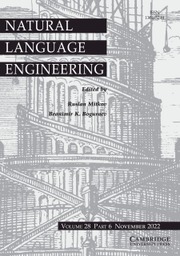No CrossRef data available.
Article contents
Explanation-based learning and finite state transducers: applications to parsing lexicalized tree adjoining grammars
Published online by Cambridge University Press: 01 December 1996
Abstract
There are currently two philosophies for building grammars and parsers: hand-crafted, wide coverage grammars; and statistically induced grammars and parsers. Aside from the methodological differences in grammar construction, the linguistic knowledge which is overt in the rules of handcrafted grammars is hidden in the statistics derived by probabilistic methods, which means that generalizations are also hidden and the full training process must be repeated for each domain. Although handcrafted wide coverage grammars are portable, they can be made more efficient when applied to limited domains, if it is recognized that language in limited domains is usually well constrained and certain linguistic constructions are more frequent than others. We view a domain-independent grammar as a repository of portable grammatical structures whose combinations are to be specialized for a given domain. We use Explanation-Based Learning (EBL) to identify the relevant subset of a handcrafted general purpose grammar (XTAG) needed to parse in a given domain (ATIS). We exploit the key properties of Lexicalized Tree-Adjoining Grammars to view parsing in a limited domain as finite state transduction from strings to their dependency structures.
Information
- Type
- Research Article
- Information
- Copyright
- 1997 Cambridge University Press

